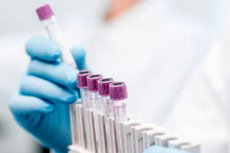New publications
Proteins in the blood may warn of cancer more than seven years before it is diagnosed
Last reviewed: 02.07.2025

All iLive content is medically reviewed or fact checked to ensure as much factual accuracy as possible.
We have strict sourcing guidelines and only link to reputable media sites, academic research institutions and, whenever possible, medically peer reviewed studies. Note that the numbers in parentheses ([1], [2], etc.) are clickable links to these studies.
If you feel that any of our content is inaccurate, out-of-date, or otherwise questionable, please select it and press Ctrl + Enter.

In a recent study published in the journal Nature Communications, British researchers looked at links between 1,463 plasma proteins and 19 cancers using observational and genetic approaches in participants from the UK Biobank. They found 618 protein-cancer associations and 317 cancer biomarkers, including 107 cases detected in the seven years before cancer diagnosis.
Proteins play a key role in most biological processes, including cancer development, and some are known risk factors or biomarkers for cancer. While previous studies have identified individual proteins associated with cancer, new multiplex proteomics methods allow for the simultaneous assessment of proteins on a large scale, particularly those that remain unexplored in the context of cancer risk.
Prospective studies face challenges due to confounding and bias, but genetic variations that affect protein levels provide additional evidence. Genetic predictors, especially cis-pQTLs (protein quantitative trait loci), provide robust evidence for associations between proteins and cancer. Integrating observational and genetic approaches increases the likelihood of identifying proteins that may be causally related to cancer development and progression.
This combined approach helps to better understand cancer biology, identify therapeutic targets, and discover diagnostic biomarkers. Therefore, in this study, the researchers used an integrated multi-omics strategy combining prospective cohort and exome analyses to identify proteins potentially involved in cancer etiology.
The study used data from the UK Biobank, a prospective cohort of 44,645 adults (after exclusions), aged 39–73 years, with a median follow-up of 12 years. Participants underwent an assessment including a questionnaire, anthropometric measurements and blood sample collection. Plasma samples were analysed using the Olink Proximity Extension Assay to quantify 1463 proteins. Cancer and death registration data were obtained through linkage to national registries. Exome sequencing data were used to examine genetic associations with protein levels.
Results and discussion Observational analyses included 4921 cancer cases with a median age of 66.9 years. People who developed cancer were found to have older age, higher levels of addiction, and a family history of cancer compared with the overall analysis sample. Women with cancer had fewer children, earlier onset of menstruation, higher levels of postmenopausal status, use of hormone replacement therapy, and no use of oral contraceptives.
A total of 371 proteins showed significant associations with the risk of at least one cancer type, resulting in 618 protein-cancer associations. Of these associations, 304 were associated with proteins enriched in mRNA expression in candidate tissues or cells of cancer origin. Most associations were found for proteins associated with hematological cancers with high mRNA expression in B cells or T cells, but associations were also found with proteins with high mRNA expression in various other tissues, such as liver, kidney, brain, stomach, lung, colon, esophagus, and endometrium.
Hematological malignancies, including non-Hodgkin's lymphoma (NHL), diffuse large B-cell non-Hodgkin's lymphoma (DLB-cell non-Hodgkin's lymphoma), leukemia and multiple myeloma, accounted for more than half of the associations identified.
Significant associations included TNFRSF13B and SLAMF7 with risk of multiple myeloma, PDCD1 and TNFRSF9 with risk of NHL, and FCER2 and FCRL2 with risk of leukemia. Additionally, associations have been found with liver cancer (e.g., IGFBP7 and IGFBP3), kidney cancer (e.g., HAVCR1 and ESM1), lung cancer (e.g., WFDC2 and CEACAM5), esophageal cancer (e.g., REG4 and ST6GAL1), colorectal cancer (e.g., AREG and GDF15), gastric cancer (e.g., ANXA10 and TFF1), breast cancer (e.g., STC2 and CRLF1), prostate cancer (e.g., GP2, TSPAN1, and FLT3LG), endometrial cancer (e.g., CHRDL2, KLK4, and WFIKKN1), and ovarian cancer (e.g., DKK4 and WFDC2).
Fewer associations were found for pancreatic, thyroid, melanoma, or lip and oral cancers. Pathway analyses suggested that the adaptive immune response may play a role in hematological cancers. Minimal heterogeneity was found after stratifying associations by sex.
A total of 107 protein-cancer associations remained significant seven years after blood collection, and genetic analyses supported 29 of them. Additionally, four associations were supported by both long-term data (>7 years) and analyses including cis-pQTL and exome protein genetic scores (exGS): NHL was associated with CD74 and TNFRSF1B, leukemia with ADAM8, and lung cancer with SFTPA2. The results identified 38 proteins associated with cancer risk that are also targets of currently approved drugs, indicating their potential for therapeutic use to reduce cancer risk.
Although this is the largest cohort study examining circulating proteins and cancer, the analysis was limited to baseline protein levels, which may have led to underestimation of risks due to mean-biased regression. There was also limited power for rare cancers and underrepresented populations, requiring further studies in diverse cohorts.
In conclusion, the study identified several links between blood proteins and cancer risk, many of which were detected up to seven years before cancer diagnosis. Genetic analyses confirmed their potential role in cancer development. Additionally, the findings may help identify proteins that may facilitate early detection of cancer stages in people at risk, offering promising biomarkers for early diagnosis and improved patient outcomes.
